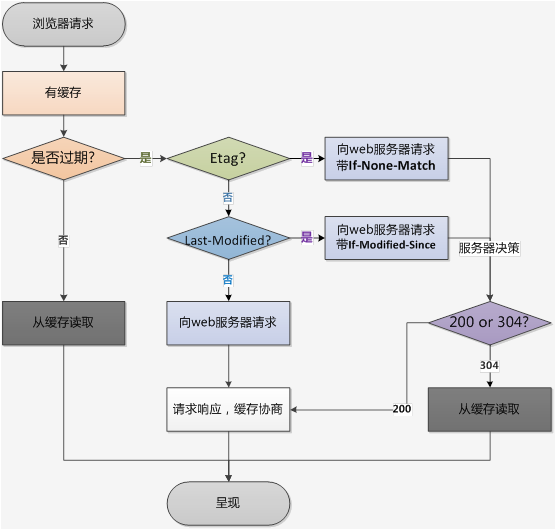上一篇文章 我们主要介绍了 OkHttp 的请求流程,这篇文章讲解一下 OkHttp 的缓存机制。
建议将 OkHttp 的源码下载下来,使用 IDEA 编辑器可以直接打开阅读。我这边也将最新版的源码下载下来,进行了注释说明,有需要的可以直接从 Android open framework analysis
在网络请求的过程中,一般都会使用到缓存,缓存的意义在于,对于客户端来说,使用缓存数据能够缩短页面展示数据的时间,优化用户体验,同时降低请求网络数据的频率,避免流量浪费。对于服务端来说,使用缓存能够分解一部分服务端的压力。
在讲解 OkHttp 的缓存机制之前,先了解下 Http 的缓存理论知识,这是实现 OkHttp 缓存的基础。
Http 的缓存机制如下图:
Http 的缓存分为两种:强制缓存和对比缓存。强制缓存优先于对比缓存。
客户端第一次请求数据时,服务端返回缓存的过期时间(通过字段 Expires 与 Cache-Control 标识),后续如果缓存没有过期就直接使用缓存,无需请求服务端;否则向服务端请求数据。
Expires
服务端返回的到期时间。下一次请求时,请求时间小于 Expires 的值,直接使用缓存数据。
由于到期时间是服务端生成,客户端和服务端的时间可能存在误差,导致缓存命中的误差。
Cache-Control
Http1.1 中采用了 Cache-Control 代替了 Expires,常见 Cache-Control 的取值有:
private: 客户端可以缓存
public: 客户端和代理服务器都可缓存
max-age=xxx: 缓存的内容将在 xxx 秒后失效
no-cache: 需要使用对比缓存来验证缓存数据,并不是字面意思
no-store: 所有内容都不会缓存,强制缓存,对比缓存都不会触发
对比缓存每次请求都需要与服务器交互,由服务端判断是否可以使用缓存。
客户端第一次请求数据时,服务器会将缓存标识(Last-Modified/If-Modified-Since 与 Etag/If-None-Match)与数据一起返回给客户端,客户端将两者备份到缓存数据库中。
当再次请求数据时,客户端将备份的缓存标识发送给服务器,服务器根据缓存标识进行判断,返回 304 状态码,通知客户端可以使用缓存数据,服务端不需要将报文主体返回给客户端。
Last-Modified/If-Modified-Since
Last-Modified 表示资源上次修改的时间,在第一次请求时服务端返回给客户端。
客户端再次请求时,会在 header 里携带 If-Modified-Since ,将资源修改时间传给服务端。
服务端发现有 If-Modified-Since 字段,则与被请求资源的最后修改时间对比,如果资源的最后修改时间大于 If-Modified-Since,说明资源被改动了,则响应所有资源内容,返回状态码 200;否则说明资源无更新修改,则响应状态码 304,告知客户端继续使用所保存的缓存。
**Etag/If-None-Match **
优先于 Last-Modified/If-Modified-Since。
Etag 是当前资源在服务器的唯一标识,生成规则由服务器决定。当客户端第一次请求时,服务端会返回该标识。
当客户端再次请求数据时,在 header 中添加 If-None-Match 标识。
服务端发现有 If-None-Match 标识,则会与被请求资源对比,如果不同,说明资源被修改,返回 200;如果相同,说明资源无更新,响应 304,告知客户端继续使用缓存。
为了节省流量和提高响应速度,OkHttp 有自己的一套缓存机制,CacheInterceptor 就是用来负责读取缓存以及更新缓存的。
我们来看 CacheInterceptor 的关键代码:
1 2 3 4 5 6 7 8 9 10 11 12 13 14 15 16 17 18 19 20 21 22 23 24 25 26 27 28 29 30 31 32 33 34 35 36 37 38 39 40 41 42 43 44 45 46 47 48 49 50 51 52 53 54 55 56 57 58 59 60 61 62 63 64 65 66 67 68 69 70 71 72 73 74 75 76 77 78 79 80 81 82 83 84 85 86 87 88 89 90 91 92 93 94 95 96 97 98 99 100 101 102 103 @Override public Response intercept (Chain chain) throws IOException Response cacheCandidate = cache != null ? cache.get(chain.request()) : null ; long now = System.currentTimeMillis(); CacheStrategy strategy = new CacheStrategy.Factory(now, chain.request(), cacheCandidate).get(); Request networkRequest = strategy.networkRequest; Response cacheResponse = strategy.cacheResponse; if (cache != null ) { cache.trackResponse(strategy); } if (cacheCandidate != null && cacheResponse == null ) { closeQuietly(cacheCandidate.body()); } if (networkRequest == null && cacheResponse == null ) { return new Response.Builder() .request(chain.request()) .protocol(Protocol.HTTP_1_1) .code(504 ) .message("Unsatisfiable Request (only-if-cached)" ) .body(Util.EMPTY_RESPONSE) .sentRequestAtMillis(-1L ) .receivedResponseAtMillis(System.currentTimeMillis()) .build(); } if (networkRequest == null ) { return cacheResponse.newBuilder() .cacheResponse(stripBody(cacheResponse)) .build(); } Response networkResponse = null ; try { networkResponse = chain.proceed(networkRequest); } finally { if (networkResponse == null && cacheCandidate != null ) { closeQuietly(cacheCandidate.body()); } } if (cacheResponse != null ) { if (networkResponse.code() == HTTP_NOT_MODIFIED) { Response response = cacheResponse.newBuilder() .headers(combine(cacheResponse.headers(), networkResponse.headers())) .sentRequestAtMillis(networkResponse.sentRequestAtMillis()) .receivedResponseAtMillis(networkResponse.receivedResponseAtMillis()) .cacheResponse(stripBody(cacheResponse)) .networkResponse(stripBody(networkResponse)) .build(); networkResponse.body().close(); cache.trackConditionalCacheHit(); cache.update(cacheResponse, response); return response; } else { closeQuietly(cacheResponse.body()); } } Response response = networkResponse.newBuilder() .cacheResponse(stripBody(cacheResponse)) .networkResponse(stripBody(networkResponse)) .build(); if (cache != null ) { if (HttpHeaders.hasBody(response) && CacheStrategy.isCacheable(response, networkRequest)) { CacheRequest cacheRequest = cache.put(response); return cacheWritingResponse(cacheRequest, response); } if (HttpMethod.invalidatesCache(networkRequest.method())) { try { cache.remove(networkRequest); } catch (IOException ignored) { } } } return response; }
整个方法的流程如下:
1、读取候选缓存。
2、根据候选缓存创建缓存策略。
3、根据缓存策略,如果不进行网络请求,而且没有缓存数据时,报错返回错误码 504。
4、根据缓存策略,如果不进行网络请求,缓存数据可用,则直接返回缓存数据。
5、缓存无效,则继续执行网络请求。
6、通过服务端校验后,缓存数据可以使用(返回 304),则直接返回缓存数据,并且更新缓存。
7、读取网络结果,构造 response,对数据进行缓存。
OkHttp 通过 CacheStrategy 获取缓存策略,CacheStrategy 根据之前缓存结果与当前将要发生的 request 的Header 计算缓存策略。规则如下:
networkRequest
cacheResponse
CacheStrategy
null
null
only-if-cached(表明不进行网络请求,且缓存不存在或者过期,一定会返回 503 错误)
null
non-null
不进行网络请求,而且缓存可以使用,直接返回缓存,不用请求网络
non-null
null
需要进行网络请求,而且缓存不存在或者过期,直接访问网络。
non-null
not-null
Header 中含有 ETag/Last-Modified 标识,需要在条件请求下使用,还是需要访问网络。
CacheStrategy 通过工厂模式构造,CacheStrategy.Factory 对象构建以后,调用它的 get 方法即可获得具体的CacheStrategy,CacheStrategy.Factory 的 get方法内部调用的是 CacheStrategy.Factory 的 getCandidate 方法,它是核心的实现。
1 2 3 4 5 6 7 8 9 10 11 12 13 14 15 16 17 18 19 20 21 22 23 24 25 26 27 28 29 30 31 32 33 34 35 36 37 38 39 40 41 42 43 44 45 46 47 48 49 50 51 52 53 54 55 56 57 58 59 60 61 62 63 64 65 66 67 68 69 70 71 72 73 74 75 76 77 private CacheStrategy getCandidate () if (cacheResponse == null ) { return new CacheStrategy(request, null ); } if (request.isHttps() && cacheResponse.handshake() == null ) { return new CacheStrategy(request, null ); } if (!isCacheable(cacheResponse, request)) { return new CacheStrategy(request, null ); } CacheControl requestCaching = request.cacheControl(); if (requestCaching.noCache() || hasConditions(request)) { return new CacheStrategy(request, null ); } CacheControl responseCaching = cacheResponse.cacheControl(); long ageMillis = cacheResponseAge(); long freshMillis = computeFreshnessLifetime(); if (requestCaching.maxAgeSeconds() != -1 ) { freshMillis = Math.min(freshMillis, SECONDS.toMillis(requestCaching.maxAgeSeconds())); } long minFreshMillis = 0 ; if (requestCaching.minFreshSeconds() != -1 ) { minFreshMillis = SECONDS.toMillis(requestCaching.minFreshSeconds()); } long maxStaleMillis = 0 ; if (!responseCaching.mustRevalidate() && requestCaching.maxStaleSeconds() != -1 ) { maxStaleMillis = SECONDS.toMillis(requestCaching.maxStaleSeconds()); } if (!responseCaching.noCache() && ageMillis + minFreshMillis < freshMillis + maxStaleMillis) { Response.Builder builder = cacheResponse.newBuilder(); if (ageMillis + minFreshMillis >= freshMillis) { builder.addHeader("Warning" , "110 HttpURLConnection \"Response is stale\"" ); } long oneDayMillis = 24 * 60 * 60 * 1000L ; if (ageMillis > oneDayMillis && isFreshnessLifetimeHeuristic()) { builder.addHeader("Warning" , "113 HttpURLConnection \"Heuristic expiration\"" ); } return new CacheStrategy(null , builder.build()); } String conditionName; String conditionValue; if (etag != null ) { conditionName = "If-None-Match" ; conditionValue = etag; } else if (lastModified != null ) { conditionName = "If-Modified-Since" ; conditionValue = lastModifiedString; } else if (servedDate != null ) { conditionName = "If-Modified-Since" ; conditionValue = servedDateString; } else { return new CacheStrategy(request, null ); } Headers.Builder conditionalRequestHeaders = request.headers().newBuilder(); Internal.instance.addLenient(conditionalRequestHeaders, conditionName, conditionValue); Request conditionalRequest = request.newBuilder() .headers(conditionalRequestHeaders.build()) .build(); return new CacheStrategy(conditionalRequest, cacheResponse); }
整个函数的逻辑就是按照上面的 Http 缓存策略流程图来实现的,这里不再赘述。
我们再简单看下 OkHttp 是如何缓存数据的。
OkHttp 具体的缓存数据是利用 DiskLruCache 实现,用磁盘上的有限大小空间进行缓存,按照 LRU 算法进行缓存淘汰。
Cache 类封装了缓存的实现,缓存操作封装在 InternalCache 接口中。
1 2 3 4 5 6 7 8 9 10 11 12 13 14 15 16 17 18 19 20 21 public interface InternalCache @Nullable Response get (Request request) throws IOException ; @Nullable CacheRequest put (Response response) throws IOException ; void remove (Request request) throws IOException void update (Response cached, Response network) void trackConditionalCacheHit () void trackResponse (CacheStrategy cacheStrategy) }
Cache 类在其内部实现了 InternalCache 的匿名内部类,内部类的方法调用 Cache 对应的方法。
1 2 3 4 5 6 7 8 9 10 11 12 13 14 15 16 17 18 19 20 21 22 23 24 25 26 27 28 public final class Cache implements Closeable , Flushable final InternalCache internalCache = new InternalCache() { @Override public @Nullable Response get (Request request) throws IOException { return Cache.this .get(request); } @Override public @Nullable CacheRequest put (Response response) throws IOException { return Cache.this .put(response); } @Override public void remove (Request request) throws IOException Cache.this .remove(request); } @Override public void update (Response cached, Response network) Cache.this .update(cached, network); } @Override public void trackConditionalCacheHit () Cache.this .trackConditionalCacheHit(); } @Override public void trackResponse (CacheStrategy cacheStrategy) Cache.this .trackResponse(cacheStrategy); } }; }
OkHttp 的缓存机制是按照 Http 的缓存机制实现。
OkHttp 具体的数据缓存逻辑封装在 Cache 类中,它利用 DiskLruCache 实现。
默认情况下,OkHttp 不进行缓存数据。
可以在构造 OkHttpClient 时设置 Cache 对象,在其构造函数中指定缓存目录和缓存大小。
如果对 OkHttp 内置的 Cache 类不满意,可以自行实现 InternalCache 接口,在构造 OkHttpClient 时进行设置,这样就可以使用自定义的缓存策略了。
